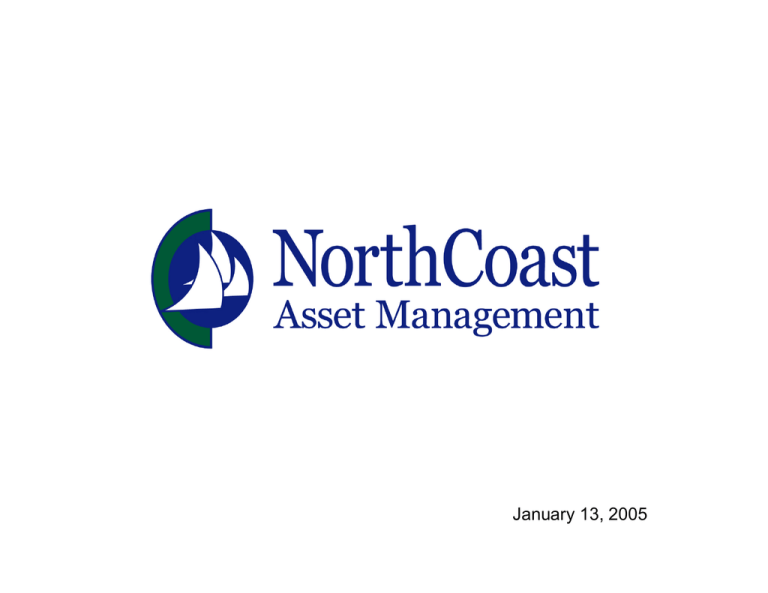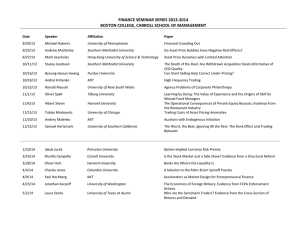January 13, 2005
advertisement

January 13, 2005 Contents Conventional, but not Wisdom Wall Street’s Simple Rules Asset Allocation Performance / Methodology Why it Works “The most successful of Wall Street are those who have received severe training, who have had some sledgehammer blows applied to their heads to temper them, like the conversion of iron to steel.” - Henry Clews 2 Conventional, but not Wisdom Buy and Hold is fine . . . if you have 40 years Secular Bear Markets Secular Bull Markets Period Duration Real Return Period Duration Real Return 1802-1815 13 2.8% 1815-1835 20 9.6% 1835-1843 8 -1.1% 1843-1853 10 12.5% 1853-1861 8 -2.8% 1861-1881 20 11.5% 1881-1896 15 3.7% 1896-1906 10 11.5% 1906-1921 15 -1.9% 1921-1929 8 24.8% 1929-1949 20 1.2% 1949-1966 17 14.1% 1966-1982 16 -1.5% 1982-2000 18 14.8% Overall 95 0.3% Overall 103 13.2% “Every generation laughs at the old fashions but follows religiously the new.” - Henry David Thoreau 3 Conventional, but not Wisdom Index, Index, and more Index $1 Billion S&P 500 indexed mutual fund assets in 1990 $500 Billion S&P 500 indexed mutual fund assets in 2004 (40% of all equity investment) “Whenever you find that you are on the side of the majority, it is time to reform.” - Mark Twain 4 Conventional, but not Wisdom Modern Portfolio Theory But But wait wait aa second second .. .. .. 1. Morningstar 5-star system is worthless in determining future performance 2. Past correlations are largely a product of coincidence 3. In times of crisis, things become suddenly highly correlated 4. The efficient frontier works only in hindsight 5. Why doesn’t a .8 beta stock or fund do what it is supposed to? “Wall Street experts have perfected the art of being wrong with confidence.” - Bennett Goodspeed 5 Simple Rules 1. Markets Change Socioeconomic Government Demographics Agencies Technology Taxes Medicine Federal Reserve Human Global Fear Politics Greed Monetary Policies War “Even if you're on the right track, you'll get run over if you just sit there.” - Will Rogers 6 Simple Rules 2. Avoid Big Losses $2,000 $1,800 a 20% Loss Needs a $1,600 $1,400 $1,200 To get Back on Track 65% Gain $1,000 $800 $600 $400 $200 $0 15% -20% 65% 15% Year 1 Year 2 Y ear 3 Y ear 4 “The first rule is not to lose money. The second rule is not to forget the first rule.” - Warren Buffet 7 Wall Street’s Simple Simple RulesRules 3. No One Knows the Future Second oldest profession – records from 5,000 years ago show forecasting methods by seeing clues in animal entrails. $200 billion predictive industry today – from stock market to meteorology to technology futurists. Accuracy less than Coin Flip – complex systems are impossible to predict. “In Wall Street the only thing hard to explain is next week.” - Louis Rukeyser 8 Using the rules Dynamic Asset Allocation 1. Markets Change -- Rotates among diverse universe of mutual funds and ETFs to produce returns. 2. Avoid Big Losses -- Scales to cash in a declining market. No shorting and no leverage. 3. No One Knows the Future -- Makes money by participating in the market – not predicting it. “To think is easy. To act is difficult. To act as one thinks is the most difficult of all.” - Johann Wolfgang von Goethe 9 Asset Allocation: Results Asset Allocation 12/31/97-12/31/04, Net of Fees 32.00 30.00 28.00 26.00 Asset Allocation 24.00 22.00 20.00 18.00 16.00 S&P 500 14.00 12.00 10.00 8.00 6.00 D ec-9 7 A p r-9 8 A ug -9 8 D ec-9 8 A p r-9 9 A ug -9 9 D ec-9 9 A p r-0 0 A ug -0 0 D ec-0 0 A p r-0 1 A ug -0 1 D ec-0 1 A p r-0 2 A ug -0 2 D ec-0 2 A p r-0 3 A ug -0 3 D ec-0 3 A p r-0 4 A ug -0 4 D ec-0 4 Summary Statistics, Net of Fees Asset Allocation S&P 500 Total Return (1/1/98 – 12/31/04) 162.5% 38.3% Annual Rate of Return 17.5% 5.6% Standard Deviation 4.6% 4.7% Beta 0.46 --- 1.24% (1.39%) --- Alpha (avg. monthly return) Past Performance does not guarantee future returns. 10 Asset Allocation: Methodology Asset Allocation is the Combination of Two Strategies 50% Foundational 50% Trading • Slow Rotator • Fast Rotator • Maximum of 20 Positions • Maximum of 8 Positions • Universe of 730 Funds • Universe of 130 ETFs and Funds • Average Hold > 100 days • Average Hold 40 days • Slowly scales into and out of cash • Quickly scales into and out of cash Uniting the Strategies Creates a Superior Portfolio 11 Asset Allocation: Methodology Foundational Foundational 12/31/00-11/30/04 Foundational S&P 500 Annual ROR 8.0% -1.4% Standard Deviation 3.3% 4.7% Sharpe Ratio 0.49 -0.24 Negative Variance -2.1% -3.2% % Positive Months 57% 57% Worst Drawdown -10.4% -37.4% 12/31/00-11/30/04 Trading S&P 500 Annual ROR 19.4% -1.4% Standard Deviation 5.5% 4.7% Sharpe Ratio 0.88 -0.24 Negative Variance -3.5% -3.2% % Positive Months 60% 57% Worst Drawdown -17.9% -37.4% 100% % Invested 90% 80% 70% 60% 50% 40% 30% 20% 10% 0% Jan-01 Jun-01 Nov-01 Apr-02 Se p-02 Fe b-03 Jul-03 De c-03 M ay-04 Oct-04 Trading Trading 100% 90% % Invested 80% 70% 60% 50% 40% 30% 20% 10% 0% Jan-01 Jun-01 Nov-01 Apr-02 Se p-02 Feb-03 Jul-03 Dec-03 M ay-04 Oct-04 12 Asset Allocation: Methodology Two Two Strategies Strategies -- Combined Combined 100% 90% % Invested 80% 70% 60% 50% 40% 30% 20% 10% 0% Jan-01 Jun-01 Nov-01 Apr-02 S ep-02 Feb-03 Jul-03 D ec -03 May-04 O c t-04 12/31/00–11/30/04 (gross of fees) Foundational Trading Combined S&P 500 Annual ROR 8.0% 19.4% 13.8% -1.4% Standard Deviation 3.3% 5.5% 4.3% 4.7% Sharpe Ratio 0.49 0.88 0.76 -0.24 Negative Variance -2.1% -3.5% -2.8% -3.2% Worst Drawdown -10.4% -17.9% -14.2% -37.4% 13 Asset Allocation: Methodology Buy Buy Rules Rules Sell Sell Rules Rules • 5-month risk-adjusted return and price performance are greater than Index* • Fund exhibits the strongest relative price acceleration over last 20 days • Fund has dropped into the bottom 50% of relative strength ratings • 1996 – 2003: 58% of trades are profitable (take losses early) Where Profits Were Made 12/00 – 11/04 100% 90% 80% Mid-Cap Japan 70% 60% 50% 40% Communications Large Growth Europe 30% Health Utilities Natural Resources 20% Technology Small & Mid-Cap Growth 10% 0% Jan-01 Energy Real Estate Large Value Jun-01 Nov-01 Apr-02 S ep-02 Feb-03 Jul-03 Small Blend Small Growth World Stock Technology International Small Cap Mid-Cap Value D ec -03 May-04 O c t-04 14 * TL’s proprietary average Fund Index. 1,400 total. Why It Works • Well established underlying principles 1. Journal of Finance (March 1993, Harvard) – Persistence of mutual fund returns 2. What Works on Wall Street (2000, McGraw-Hill) – Relative Strength is the top performing growth factor 3. Style Investing (1995, John Wiley) – Excess returns generated from market segmentation 4. Journal of Portfolio Management (1999, CU) “What drives mutual fund returns” – Weigand 5. Taking Losses early – “take care of what is difficult while it is still easy” • Experience-based rules . . . Consistently applied 1. Discipline over Intuition – 85% of money managers fail to outperform S&P 500 because they do not consistently apply their strategy or “Everybody has a plan until they get punched in the mouth” 2. Explicit, written investment rules and policy – two changes in eight years • Risk Management / Capital Preservation 1. Goes to cash in declining market. A clearly defined exit discipline and hedge vehicle. 2. 5% maximum, single position / 20% concentration maximum in volatile sectors 3. No shorting or use of leverage “The first rule is not to lose money. The second rule is not to forget the first rule” - Warren Buffet 15 Appendix • Fixed Income Program • Fund Universe • Principals 16 Fixed Income Results 7.50% 1600 7.00% 1500 6.50% 10-Year Government Bond Rate 6.00% 1400 5.50% 1300 5.00% 1200 4.50% NorthCoast’s Fixed Income 4.00% 1100 1000 3.50% 3.00% Jan-96 900 Sep-96 M ay-97 Jan-98 Sep-98 M ay-99 Jan-00 Sep-00 M ay-01 Jan-02 Sep-02 M ay-03 Fixed Income Bond Index Annual Rate of Return 4.7% 2.6% Standard Deviation 0.8% 1.0% Worst Drawdown -2.8% -3.1% Worst Year 2.4% -1.1% 1/96 – 11/04, Net of Fees Jan-04 Sep-04 17 Fixed Income Fact Sheet Objective Return primarily from Interest Dividends. For consideration versus holding low yielding money market funds. Diversification The portfolio holds up to 10 U. S. registered mutual funds investing in fixed income securities – both US and abroad. Risk Control The portfolio automatically moves assets to those sectors demonstrating market strength and away from declining sectors. In broad declining bond markets, will scale into cash to preserve capital. No Down 12- Month periods. Performance Average annual return 4.7% vs. Bond Index of 2.6%. 18 Fund Universe Sm all Blend Mid-Cap Value Sm all Growth Sm all Value Com m unication Financial Health Natural Res Precious Metals Mid-Cap Growth Real Es tate Technology Mid-Cap Blend Utilities Divers ified Em erging Mkts Divers ified Pacific/As ia Stock Europe Stock Foreign Growth Large Value Foreign Value Japan Stock Latin Am erica Stock Pacific/As ia ex-Japan Stock World Stock Large Growth Large Blend 19 Who We Are Paul E. Dean, Chairman. Mr. Dean graduated from Georgia Institute of Technology in 1966 with a B.S degree in Industrial Engineering and earned a MBA from Harvard University in 1968. He has been involved in researching, developing and implementing futures trading strategies and programs based on trend-timing trading philosophy since 1974. Mr. Dean was the partner of the late Richard D. Donchian, one of the first advocates of the diversified trendfollowing approach to managed futures. He co-founded TrendLogic in 1988. J. Richard Semels, CEO. Mr. Semels graduated from the University of Connecticut in 1964 with a B.A. degree in English. Mr. Semels spent ten years in advertising, then joined Salomon Smith Barney Inc. where he held the title Senior Vice President-Investments. He has been involved in researching, developing and implementing trading and risk management systems for use in the futures and securities markets since 1975. Mr. Semels co-founded TrendLogic in 1988. Daniel J. Kraninger, President. Previously, Mr. Kraninger was Senior Vice President of GE Private Asset Management (GEPAM) a $2.5 billion money management subsidiary of GE Capital. His responsibility at GEPAM was directing their Private Client Group - a team that advised and managed money for over 1,500 high-net worth clients. Prior to GE, he served as Senior Vice President of O'Shaughnessy Capital Management (OCM), a $1 billion Greenwich investment adviser and mutual fund manager that he helped establish in 1996 with founder, Jim O'Shaughnessy. OCM later sold its assets to Netfolio, LLC in January, 2000. Before OCM, Mr. Kraninger worked at Merrill Lynch as a member of the 1994 JET Program, and he is a graduate of Villanova University. Warren K. Greene, Senior Vice President. Previously, Mr. Greene was president of the American Investors group of mutual funds, which he joined from The First Boston Corporation in New York. American Investors pioneered relative-strength analysis applied to stocks and industry groups. He was portfolio manager of American Investors Growth Fund, American Investors Income Fund, and American Investors Option Growth Fund. He served as president of the No-Load Mutual Fund Association and Chairman, No-Load Committee of the Investment Company Institute. Mr. Greene is a member the New York Society of Security Analysts, Inc. and the Association of Investment Management and Research. He graduated from Oregon State University with a B.S. degree in Industrial Engineering and from New York University with a MBA degree. Brentin C. Elam, Vice President and Director. Mr. Elam graduated from the University of Cincinnati in 1969 with a B.S. degree in Science. Mr. Elam has traded futures professionally since 1970, using and writing computer programs for trading portfolios. He was a founding director of the National Association of Futures Trading Advisors and has served on the National Futures Association’s CTA/CPO Advisory Committee and the NFA’s Business Conduct Committee, Eastern Region. Harry H. Suber, Ph.D, Director of Research. From 1960 to 1969, Dr. Suber attended Clemson University in South Carolina earning a B.S. (cum laude) in Physics, a MS in Mathematics and a Ph.D in Mathematics. He was an Associate Professor with the Department of Mathematics at Salisbury University in Maryland from 1969 to 1990. Dr. Suber is a co-founder of TrendLogic and has been the Director of Research since May, 1988. He has primary responsibility for computer-assisted research and programming for TrendLogic’s portfolio management models and systems. Robert Tardiff, Ph.D, Assistant Director of Research. Dr. Tardiff earned his Ph.D in Mathematics from the University of Massachusetts in 1975. In 1982, he joined the faculty at Salisbury University, becoming a full Professor of Mathematics in 1989. Subsequently he was Chairman of the Computer Science and Mathematics Department, and currently is Dean, Henson School of Science and Technology, Salisbury University. Dr. Tardiff performs research programming and system/data base management for TrendLogic’s programs. 20




